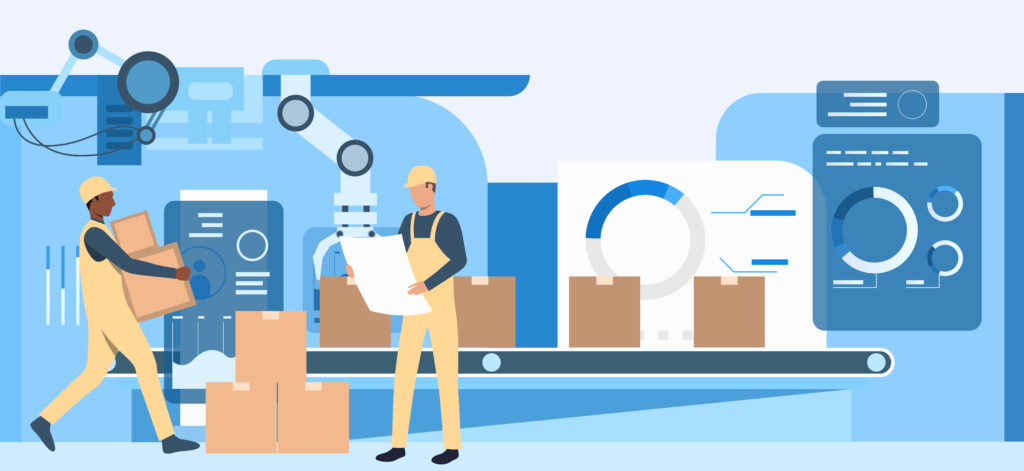On-Demand vs Bulk Manufacturing for Packaging Vendors - What’s Best for Healthcare MSMEs?
Table of Contents
Introduction:
In today’s fast-moving healthcare supply ecosystem, packaging vendors serving Healthcare MSMEs must make a strategic choice between on-demand manufacturing and bulk production.
This decision can make or break profitability, especially when dealing with fluctuating orders, perishable medical supplies, or tight cash cycles.
Many small businesses struggle with overstocked cartons, outdated packaging designs, or packaging shortages during peak demand.
At the core of this lies one critical business factor: inventory management.
Choosing between on-demand vs bulk manufacturing impacts production costs, lead times, inventory holding, and working capital requirements.
For packaging vendors supplying to clinics, diagnostic labs, pharmacies, and medical equipment distributors, aligning production with order frequency is crucial.
In this article, we’ll decode both models, compare their benefits and risks, and help you decide the best route to optimize costs while staying agile in the competitive healthcare packaging market.
Let’s begin with understanding each model in detail.
1. What is the Difference Between On-Demand and Bulk Manufacturing for Medical Packaging Suppliers?
When serving Healthcare MSMEs, packaging vendors must choose between on-demand manufacturing and bulk production based on their clients’ needs, order volumes, and inventory strategy.
Here’s how they differ:
On-Demand Manufacturing
- Production Triggered by Orders: Packaging is manufactured only when a confirmed order is received.
- Lower MOQs (Minimum Order Quantities): Ideal for customized or short-run packaging needs.
- Faster Adaptability: Enables rapid design changes, compliance updates, and branding tweaks.
- Minimal Inventory Holding: Since items are made just-in-time, warehouse costs are reduced.
Bulk Manufacturing
- Forecast-Based Production: Packaging is produced in large quantities based on expected demand.
- Higher MOQs: Manufacturers often require large orders to justify setup costs and machine efficiency.
- Lower Unit Cost: Per-unit prices drop due to economies of scale in raw materials and labor.
- Higher Inventory Holding: Finished goods are stored for dispatch, tying up cash and storage space.
Factor | On-Demand Manufacturing | Bulk Manufacturing |
Trigger | Order-based | Forecast-based |
MOQ | Low | High |
Flexibility | Very High | Low to Moderate |
Unit Cost | Higher | Lower (per unit) |
Inventory Management Need | Minimal | High (requires warehousing) |
Ideal For | Custom, small-run, urgent orders | High-volume, stable SKUs |
Inventory management plays a central role in both models.
On-demand reduces inventory risk, while bulk lowers cost but increases holding pressure. The right choice depends on your customer base, cash flow, and storage capacity.
2. When Should Small Packaging Vendors Choose Bulk Manufacturing Over On-Demand Production?
For small packaging vendors supplying to Healthcare MSMEs, choosing between on-demand vs bulk manufacturing depends on demand patterns, product type, and cash flow cycles.
While on-demand offers flexibility, bulk manufacturing becomes the smarter choice in the following scenarios:
1. Predictable Demand from Repeat Buyers
If you consistently serve clinics, diagnostic labs, or pharma distributors who place repeat orders,
especially for standard medical packaging like blister packs, sachets, or boxes, bulk production reduces production downtime and ensures readiness for large dispatches.
2. Lower Unit Cost is a Priority
Bulk manufacturing allows vendors to buy raw materials in large quantities at discounted rates.
Combined with full-capacity machine runs, this brings down the per-unit cost significantly, critical for price-sensitive B2B buyers in the healthcare space.
3. Products with Long Shelf Life
When packaging items such as PET bottles, cardboard boxes, or laminated pouches that don’t expire or degrade quickly, producing in bulk ensures stock longevity and avoids frequent setup or recalibration.
4. High-Volume B2B Orders
For vendors supplying large hospitals, pharma warehouses, or government tenders, bulk production is ideal.
These clients usually require thousands of identical units within tight timelines, making on-demand production too slow and inefficient.
5. Lower Logistic Disruptions
Stocking pre-manufactured inventory helps mitigate delivery delays, especially when transport strikes, raw material price spikes, or supplier issues occur.
Summary Table
Condition | Should You Choose Bulk Manufacturing? |
Steady repeat demand | ✅ Yes |
The goal is to reduce the cost per unit | ✅ Yes |
Products have a long shelf life | ✅ Yes |
Supplying large-volume B2B buyers | ✅ Yes |
Unpredictable or customized demand | ❌ No |
Limited storage capacity or cash flow | ❌ No |
In short, bulk manufacturing is the right fit when efficiency, cost savings, and volume consistency matter more than flexibility.
It works especially well when inventory management is optimized to avoid overstocking and ensure timely cash flow recovery.
3. What Are the Cost-Saving Advantages of On-Demand Packaging for Custom or Low-Volume Buyers?
For packaging vendors working with Healthcare MSMEs and niche product sellers, on-demand manufacturing offers several practical cost-saving benefits, especially when catering to custom or small-batch orders.
Unlike bulk manufacturing, this model helps reduce financial risk and improve cash flow predictability.
1. Reduced Wastage of Materials and Resources
In on-demand production, you only manufacture what’s required—no more, no less. This reduces the risk of:
- Overproduction of packaging that doesn’t get sold
- Expiry or obsolescence of packaging for seasonal herbal or Ayurvedic products
- Damaged inventory due to poor storage conditions
By minimizing excess, vendors avoid tying up money in non-moving stock.
2. Flexibility in Product Customization
Medical and wellness buyers, especially smaller clinics or local Ayurvedic brands, often need custom packaging:
- Different label designs
- Variable quantities
- Special sizes or eco-friendly materials
On-demand manufacturing allows vendors to accommodate such variation without the need to commit to large minimum order quantities (MOQs), enabling better client retention and premium pricing.
3. Lower Inventory Holding Costs
Bulk production usually demands storage space, climate control (for certain packaging), and stock monitoring. On-demand production removes this burden:
- No need to pay for warehouse rent or manage aging stock
- Inventory costs are replaced by more agile production-to-dispatch cycles
- Capital is freed up for marketing, procurement, or machinery upgrades
This model is especially suited for vendors who operate in tight working capital cycles and need faster inventory turnover.
4. Easier to Pilot New Products
Packaging vendors can test new designs or materials with smaller batches, gather client feedback, and iterate without a large upfront investment.
This is critical for serving Healthcare MSMEs, introducing new private-label products, or wellness SKUs.
Summary of On-Demand Manufacturing Benefits for Low-Volume Buyers
Benefit | How It Saves Cost |
Less wastage | Only print/produce what is needed |
Custom order flexibility | Charge more for niche packaging; no bulk dependency |
Minimal inventory cost | No warehouse or overstock expenses |
Low-risk product testing | Avoid large investments in unproven formats |
In conclusion, on-demand manufacturing is ideal for customization-driven, low-volume orders, offering not only cost control but also higher responsiveness to client needs in a rapidly evolving healthcare packaging market.
4. How Do Order Frequency and Buyer Behavior Impact Your Manufacturing Model Choice?
For Packaging Vendors serving Healthcare MSMEs, choosing between on-demand vs bulk manufacturing depends heavily on understanding your buyers’ behavior and order frequency.
Different types of buyers, like clinics, diagnostic labs, or hospitals, have unique purchasing patterns that influence your optimal production strategy.
1. High-Frequency Orders = Candidate for Bulk Production
If your buyers place regular, predictable orders—especially in large volumes—bulk manufacturing becomes more cost-effective.
Example:
- Large hospitals are ordering PPE packaging monthly
- Chain pharmacies need consistent labeling or strip packaging
Why bulk works here:
- Predictable demand lowers the risk of overproduction
- You can leverage economies of scale and reduce per-unit costs
- Easier to negotiate lower rates for raw materials
2. Irregular or Seasonal Orders = Best for On-Demand
Clinics or labs in Tier 2/3 cities may order only when stock runs out or during seasonal peaks (e.g., monsoon, flu season). For such cases, on-demand is more flexible.
Why on-demand suits better:
- Prevents overstocking of slow-moving packaging SKUs
- Reduces cash tied up in inventory
- Enables personalized orders or limited-time packaging (e.g., for festive health campaigns)
3. Customization Requests = Lean Towards On-Demand
Ayurvedic suppliers and wellness brands often ask for customized designs, packaging inserts, or eco-friendly formats. These clients usually place small, irregular orders.
Packaging vendors benefit from using digital printing or modular production lines to handle such jobs without committing to bulk runs.
4. Long-Term B2B Contracts = Favor Bulk Production
If you’ve secured long-term agreements or subscription-based supply deals with diagnostic chains or healthtech companies, you can safely shift to bulk production.
Advantages:
- Reduces manufacturing cost
- Optimizes scheduling and capacity utilization
- Stabilizes your monthly revenue
Comparison Table: Buyer Behavior vs Production Model
Buyer Type | Order Pattern | Recommended Model | Reason |
Large Hospital | Regular, high volume | Bulk Manufacturing | Predictable needs, cost efficiency |
Local Clinic | Sporadic, small batch | On-Demand | Avoid overstocking, low upfront investment |
Ayurvedic Brand | Custom, irregular | On-Demand | Custom SKUs, limited-run packaging |
Health Chain | Contract-based | Bulk Manufacturing | Secure demand, optimized production planning |
By mapping your customers’ buying behavior, Packaging Vendors can make informed decisions about on-demand vs bulk manufacturing and align it with inventory management and cash flow strategies.
This approach helps reduce waste, improve margins, and meet buyer expectations more effectively.
5. What Tools or Methods Can Help Packaging Vendors Decide Between On-Demand and Bulk Runs?
To make the right decision between on-demand vs bulk manufacturing, Packaging Vendors must rely on data, not just instinct.
Smart tools and simple methods can help evaluate customer demand, production costs, and inventory risk, especially for Healthcare MSMEs.

1. Demand Forecasting Templates
Start with basic forecasting models to understand how much your buyers are likely to order in the coming months.
Tools to Use:
- Excel-based sales forecast templates
- Google Sheets with seasonality formulas
- POS data export from B2B portals like Medikabazaar or IndiaMART
Why it’s useful:
Helps estimate recurring demand, so you can batch similar orders and plan procurement smartly.
2. Production Cost Calculators
These are essential to compare per-unit manufacturing costs in bulk vs on-demand settings.
Example Inputs:
- Raw material cost per unit
- Setup/labor cost per run
- Machine downtime for custom orders
Tools to Try:
- Manufacturing cost breakdown spreadsheets
- Custom-built Google Sheets with macros
- ERP software modules like Marg ERP or TallyPrime Manufacturing
3. Inventory Holding Cost Analysis
Use this to determine how long inventory stays unsold and what that’s costing you in warehousing, damage, or expiration.
Metrics to Track:
- Inventory turnover ratio
- Average stockholding days
- Monthly storage cost
How to use it:
If bulk runs increase holding cost more than the per-unit savings, it might be better to go on-demand, especially for niche or seasonal packaging.
4. Order Frequency Dashboards
Tracking order intervals and volume by buyer segment helps understand whether batching production makes sense.
Tools:
- CRM reports from platforms like Zoho CRM
- Marg ERP’s sales order report
- Custom Excel dashboards with pivot tables
Use case:
Helps match buyer behavior to your production model—high-frequency = bulk, low-frequency = on-demand.
5. Breakeven Analysis Charts
Plot breakeven points for both models. For example:
- At what quantity does bulk become cheaper?
- How much customization can you handle before on-demand becomes inefficient?
Suggested formats:
- Excel bar charts
- Sankey diagrams for visualizing costs and risks
- ROI calculators based on buyer categories
Sample Table: Tool vs Use Case
Tool / Method | Helps With | Best For |
Sales Forecast Sheet | Estimating future demand | Monthly demand planning |
Production Cost Calculator | Comparing unit economics | Manufacturing decision-making |
Inventory Holding Tracker | Analyzing stock risks | Lean inventory strategy |
CRM Order Dashboard | Buyer pattern analysis | Model selection by buyer type |
Breakeven Graph (Bulk vs Custom) | Deciding batch size and run type | Strategic cost planning |
By combining these practical tools, Packaging Vendors serving Healthcare MSMEs can confidently choose between on-demand and bulk manufacturing.
It allows you to stay profitable, reduce wastage, and align with real market behavior, especially as demand shifts rapidly across platforms and seasons.
Conclusion: Making the Right Manufacturing Choice for Long-Term Profitability
For Healthcare MSMEs and Packaging Vendors, the decision between on-demand vs bulk manufacturing is no longer just a matter of convenience, it’s a strategic necessity.
Each model has clear benefits: bulk production reduces per-unit cost for predictable, high-volume orders, while on-demand ensures agility and reduces inventory risk for niche or custom needs.
To avoid costly missteps, suppliers must analyze inventory management, order cycles, buyer behavior, and production economics.
Tools like demand forecasting sheets, breakeven calculators, and ERP reports can give valuable insights before locking in production commitments.
Also, don’t underestimate the power of staying flexible, especially in sectors driven by variable demand like healthcare.
Ultimately, the right approach balances volume, efficiency, and customer satisfaction. Smart packaging vendors know when to scale and when to stay lean.
Following Video Might be Helpful for You
Also Read,
- The Ultimate Guide: Working Capital Loans for Small Business (MSMEs) in 2025
Understanding the Impact of Payment Terms on Working Capital for Clinics
How Poor Inventory Management Hurts Working Capital in Pharmacies.
Want a Better Business Credit Score? Small Pharmacies Can Now Use UPI & Cards to Build It
Want a Better Credit Score? Use Small Daily Payments to Build Your CBIL (For Clinics & Pharmacies)
Case Study:How a Small Clinic Improved Its Working Capital Management





